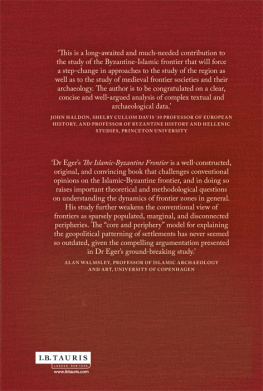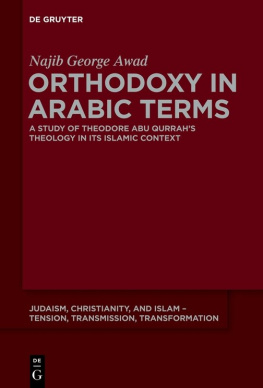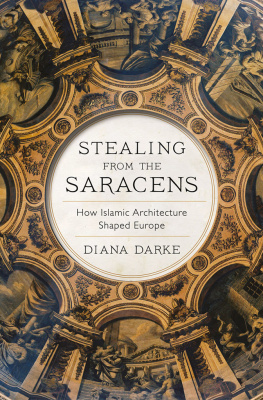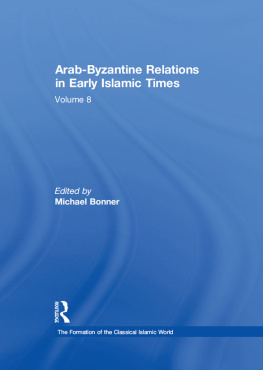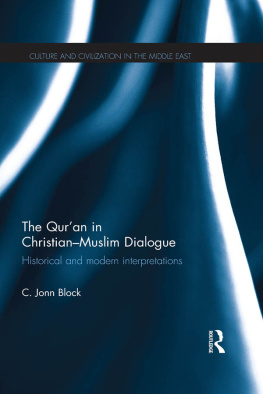A. Asa Eger - The Islamic-Byzantine Frontier: Interaction and Exchange Among Muslim and Christian Communities
Here you can read online A. Asa Eger - The Islamic-Byzantine Frontier: Interaction and Exchange Among Muslim and Christian Communities full text of the book (entire story) in english for free. Download pdf and epub, get meaning, cover and reviews about this ebook. year: 2016, publisher: I.B. TAURIS, genre: Romance novel. Description of the work, (preface) as well as reviews are available. Best literature library LitArk.com created for fans of good reading and offers a wide selection of genres:
Romance novel
Science fiction
Adventure
Detective
Science
History
Home and family
Prose
Art
Politics
Computer
Non-fiction
Religion
Business
Children
Humor
Choose a favorite category and find really read worthwhile books. Enjoy immersion in the world of imagination, feel the emotions of the characters or learn something new for yourself, make an fascinating discovery.
- Book:The Islamic-Byzantine Frontier: Interaction and Exchange Among Muslim and Christian Communities
- Author:
- Publisher:I.B. TAURIS
- Genre:
- Year:2016
- Rating:4 / 5
- Favourites:Add to favourites
- Your mark:
- 80
- 1
- 2
- 3
- 4
- 5
The Islamic-Byzantine Frontier: Interaction and Exchange Among Muslim and Christian Communities: summary, description and annotation
We offer to read an annotation, description, summary or preface (depends on what the author of the book "The Islamic-Byzantine Frontier: Interaction and Exchange Among Muslim and Christian Communities" wrote himself). If you haven't found the necessary information about the book — write in the comments, we will try to find it.
A. Asa Eger: author's other books
Who wrote The Islamic-Byzantine Frontier: Interaction and Exchange Among Muslim and Christian Communities? Find out the surname, the name of the author of the book and a list of all author's works by series.
The Islamic-Byzantine Frontier: Interaction and Exchange Among Muslim and Christian Communities — read online for free the complete book (whole text) full work
Below is the text of the book, divided by pages. System saving the place of the last page read, allows you to conveniently read the book "The Islamic-Byzantine Frontier: Interaction and Exchange Among Muslim and Christian Communities" online for free, without having to search again every time where you left off. Put a bookmark, and you can go to the page where you finished reading at any time.
Font size:
Interval:
Bookmark:
A. Asa Eger is Assistant Professor in the Department of History at the University of North Carolina, Greensboro. He holds a PhD in Islamic Archaeology from the University of Chicago.
THE ISLAMIC
BYZANTINE
FRONTIER
Interaction and Exchange Among Muslim
and Christian Communities
A. A SA E GER

Published in 2015 by I.B.Tauris & Co Ltd
6 Salem Road, London W2 4BU
175 Fifth Avenue, New York NY 10010
www.ibtauris.com
Distributed in the United States and Canada
Exclusively by Palgrave Macmillan
175 Fifth Avenue, New York NY 10010
Copyright 2015 A. Asa Eger
The right of A. Asa Eger to be identified as the author of this work has been asserted by the author in accordance with the Copyright, Designs and Patents Act 1988.
All rights reserved. Except for brief quotations in a review, this book, or any part thereof, may not be reproduced, stored in or introduced into a retrieval system, or transmitted, in any form or by any means, electronic, mechanical, photocopying, recording or otherwise, without the prior written permission of the publisher.
Every attempt has been made to gain permission for the use of the images in this book. Any omissions will be rectified in future editions.
References to websites were correct at the time of writing.
Library of Middle East History 34
ISBN: 978 1 78076 157 2
eISBN: 978 0 85773 674 1
A full CIP record for this book is available from the British Library
A full CIP record is available from the Library of Congress
Library of Congress Catalog Card Number: available
To my parents
You should know that an area does not become illustrious by the number of its
settlements, but rather by the importance of its rural districts
Muqaddas, san al-taqsm f marifat al-iqlm, 1906, p. 228.
Translation by Basil Collins, The Best Divisions for the Knowledge of Regions, 2001, p. 189.
CONTENTS
LIST OF FIGURES AND TABLES
Figures
The thughr and awim
Tribes on the thughr
The thughr with natural features represented
The Central thughr
The Amuq Plain
The Amuq Plain, Late Roman through Middle Islamic sites
The Kahramanmara Plain, Early Islamic through Middle Islamic sites
Late Roman and Early Islamic excavated building (photo courtesy of S. Campbell)
Nahr Sajr Survey, Late Roman and Islamic sites
Jabbl Survey, Late Roman through Middle Islamic sites (based on Yukich 2012)
Middle Islamic sites (based on Wilkinson 2004, Figures 7.8, 7.9, 7.10, 9.1; Wilkinson 2007, Figure 1; Algaze et al. 1994, Figure 17)
Tell Rifaat Survey, Late Roman through Middle Islamic sites (based on Matthers 1981)
Sweyhat Survey, Late Roman through Middle Islamic sites
The eastern thughr
on Blaylock et al., 1980, Figure 30)
Group II, Karababa Basin Surveys, Late Roman through Middle Islamic sites (based on Wilkinson 1990: Figures 5.4 and 5.7; Redford 1998, Figure 7.2; Algaze et al. 1992, Figure 14; Gerber 1994, pp. 327 and 331)
Avan and Altnova Surveys, Byzantine and Islamic sites (based on Whallon 1979, Figure 3)
The Jazra
Survey, Late Roman and Islamic sites (based on Yardmc 2004, 393 and 394)
Group I, Khbr Survey sites, Late Roman and Islamic sites
Balikh Survey, Late Roman through Middle Islamic sites (based on 1996, pp. 345 and 348)
Group II, Khbr Survey sites, Late Roman/Ssnian through Middle Islamic sites
Islamic sites (based on Berthier 2001, Map D) 151
The western thughr
Cilicia Survey (based on Seton-Williams 1954)
Yumurtalk-Iskenderun Survey, Late Roman through Middle Islamic sites
Tpra Field/in al-Tint, eastern gate and internal rooms (courtesy of M.-H. Gates)
in Maslama sketch adapted from Haase 2006; Tell Brak; Kurban Hyk from Algaze 1990, Figure 124; in al-Tnt by the author
Caliphal renovations, and bar graph
The Byzantine frontier
Tables
Surveys on the thughr, late period settlement
Settlement patterns on the thughr
ACKNOWLEDGEMENTS
If one looks hard enough, one can see just about anything. A patch of grass, when stared at for hours, is still an unremarkable patch of grass. Yet when one gets down on hands and knees, an entire microcosm unfolds, a multitude of creatures moving around and interacting with one another, and with the growing world around them. This book first began as an unnamed, unremarkable low-mounded patch of land, AS 257, that I surveyed along with other members of my team in 2001 in the Amuq Valley. The site soon turned out to be quite revealing. It was one of three, evenly spaced along a canal and newly founded in the seventh century. The canal was among several channels irrigating the Amuq Valley and in one of many lowland plains settled, irrigated and cultivated on the IslamicByzantine frontier. So my interest expanded and took shape, initially as a dissertation and finally into a study of the landscape of the entirety of the frontier and its neighbouring lands. Not a microcosm.
The entire process is the product of much wonderful collaboration and could not have been done without the inspiration, motivation, assistance and cooperation of a large and significant group of individuals. From the onset, I would like to thank my incredible University of Chicago dissertation committee: my advisor Donald Whitcomb, Fred Donner and Walter Kaegi, all three of whom have returned to the thughr many times throughout their scholarship and together formed the perfect team. I would also like to thank Adam Smith, who, as an outside reader, provided an important anthropological perspective on the research. In the field, my list of colleagues to whom I owe great debts of gratitude is happily long, and to name but a select few: Tony Wilkinson, Jesse Casana, Aslhan Yener, David Schloen, Fokke Gerritsen, Rana zbal, Tasha Vorderstrasse, Timothy Harrison, Steve Batiuk and Amir Sumakai Fink for the Amuq survey; Liz Carter, Stuart Campbell, Liz Mullane, Mhairi Campbell, Claire Heywood, Ben Gearey, Will Fletcher and Kate Grossman for the Mara Survey; and Marie-Henriette Gates, Fran Cole, Salima Ikram, Ben Claasz Coockson, Rado Kabatiarova, Tim Beach, Canan akrlar, Carolyn Swan and the tireless Turkish and American undergraduates for the Tupra Field survey and excavations. Many people who have provided me along the way with useful insights and comments great and small must be thanked: Hugh Kennedy, McGuire Gibson, Gil Stein, Scott Branting, Seth Richardson, John Woods, Carrie Hritz, Linda Wheatley-Irving, Rana Mikati, and Derek Krueger; and my support group while at Chicago: Alyssa Gabbay, Pat Wing, Mayte Green, Adrian de Gifis, Vanessa de Gifis, Jonathan Brown, Yuval ben Bassat, Nukhet Varlk and Noha Forster.
This book was largely written during my stay as a Fellow at Dumbarton Oaks in the spring of 2012. My fellow Byzantine Fellows, lovingly strengthened by Margaret Mullett and the larger Dumbarton Oaks community, provided stimulating conversations. The library and gardens formed a perfect setting in which to write on landscapes. In particular, this book could not have been completed without the meticulous comments of John Haldon and the second anonymous reviewer throughout. Andrea de Giorgi, Lynn Swartz Dodd, Ian Straughn, Jason Ur, Gunder Varnlolu, Michael Decker, Charles Gates, Stephen McPhillips, Bethany Walker and Alyssa Gabbay all provided comments, corrections, citations and clarity to individual chapters. Many thanks are also due to Ari Lukas, Luke Kaiser, Claire Ebert and Reed Goodwin for assistance with producing the geographic information system-based maps and to Kyle Brunner, Ian McDonald, Maria Marsh, and Allison Walker for all their help in editing. A last note of gratitude is for my family and friends, whose persistent support and encouragement was boundless and enabled me to traverse this frontier wilderness, this excellent country, these beautiful lands, with their parts untamed and parts organized, teeming with activity.
Next pageFont size:
Interval:
Bookmark:
Similar books «The Islamic-Byzantine Frontier: Interaction and Exchange Among Muslim and Christian Communities»
Look at similar books to The Islamic-Byzantine Frontier: Interaction and Exchange Among Muslim and Christian Communities. We have selected literature similar in name and meaning in the hope of providing readers with more options to find new, interesting, not yet read works.
Discussion, reviews of the book The Islamic-Byzantine Frontier: Interaction and Exchange Among Muslim and Christian Communities and just readers' own opinions. Leave your comments, write what you think about the work, its meaning or the main characters. Specify what exactly you liked and what you didn't like, and why you think so.

